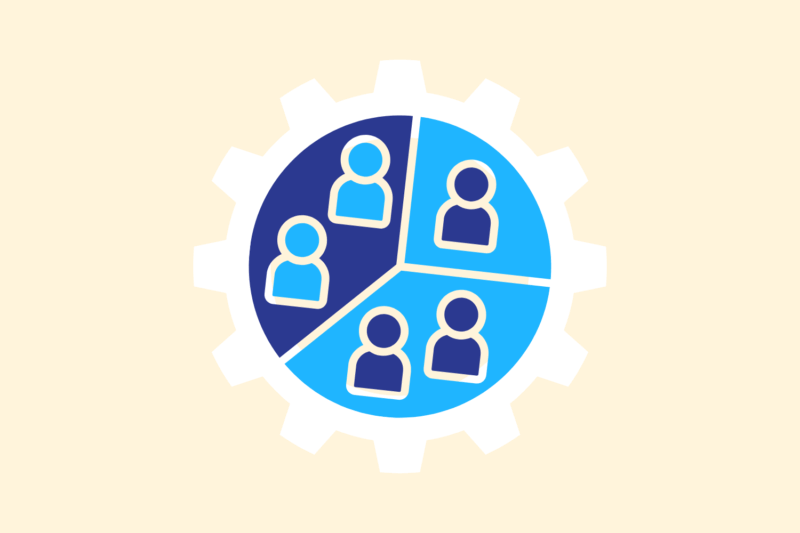Using audience segmentation to convert more

Audience segmentation is one of the most effective ways to increase the number of conversions you get. Instead of one generic message for everyone, divide your audience into specific groups, with similar characteristics or needs. Targeting these segments makes your message more relevant and persuasive. With more data and AI support than ever and consumer behavior constantly changing, audience segmentation is crucial to achieving optimal success online.
What exactly is audience segmentation?
Target group segmentation is the process of dividing your overall target audience into smaller groups that have a lot in common. For example, you divide these groups by age, gender, behavior, interests or even specific life stages. Of course, you can also target a specific geographic area. In any case, the goal is to approach each target group with a message that best suits their situation.
Voorbeelden van segmentatiecriteria zijn leeftijd, locatie, koopgedrag, betrokkenheid op je website of interactie met eerdere campagnes. Hoe specifieker en relevanter de segmentatie, hoe groter de kans dat de boodschap aankomt bij de juiste doelgroep. (1)
Why segmentation increases conversions
Segmentation works because you show people something that really suits them. People respond better to marketing that is responsive to their needs and context. This is true for both advertising and informational content. When your target audience feels addressed, it increases the likelihood that they will take action. (2)
There are three things you should pay attention to in order for segmentation to help increase conversions:
- Better timing: send your messages when the recipient is most receptive to them
- More targeted message: your content should connect to specific pain points or desires of your target audience
- Higher engagement: relevant communication invites interaction and action
Segmentation in an AI-driven environment
With the use of AI tools, segmentation becomes even more powerful. Instead of manually creating lists, you use AI to recognize patterns in customer behavior, purchase history and interactions. That way you get segments based not just on age or location, but on real behavior and interests.
AI helps you see which customers are likely to buy or purchase something from you soon. This makes it possible to make campaigns very relevant while making them easy to manage.
Getting started with SEO? Feel free to get in touch.

Matching content and message to your segments
An important part of audience segmentation is creating content that fits each segment. This goes beyond just tweaking a title or image. You tailor the tone of voice, call-to-actions and even the information hierarchy to the specific group.
For a segment already familiar with your brand, you can be more direct and concrete about your offerings. For a segment that has yet to convince you, it is more important to build trust first with informative content.
Optimize by segment
Segmentation works best when you accurately measure your results for each target group. By looking at conversion rates, click-through rates and engagement by segment, you can see which groups are yielding the most and where optimization is needed.
AI helps with this by automatically identifying the best performing segments and recommending improvements. This way, you ensure that your strategy is constantly evolving.
How an online shop reached its target audience better
A medium-sized webshop in sustainable personal care products noticed that conversion was stagnating, despite increasing visitor numbers. The emails and ads were the same for everyone, regardless of buying behavior or interests.
We decided to segment the target audience based on purchase history and behavior on the website. For example, customers who previously bought products for sensitive skin were presented with content about products with natural ingredients. In contrast, new visitors received more explanations about the brand’s mission. (3)
Within two months, click-through rates increased by 37% and repeat purchases increased by 22%. By making the message more relevant per segment, the communication became more personal and more effective.
Those who continuously optimize their segmentation based on behavior and data structurally build higher conversions.
The pitfalls of audience segmentation
While segmentation offers many benefits, there are also things to watch out for:
- Over-segmentation: I always make sure not to over-segment audiences. Too many small segments make campaigns cluttered and difficult to manage
- Lack of current data: Outdated segments lead to irrelevant communications
- Too few different messages: If you use the same content for different segments, the benefit of segmentation disappears
By avoiding these pitfalls, I use effective segmentation.
Summary
Audience segmentation is one of the most powerful tools for increasing conversions. By dividing your audience into logical, relevant groups and tailoring your message accordingly, you increase the likelihood that visitors will take action. With AI and advanced analytics tools, segmentation not only becomes more accurate, but also more efficient to manage. The key remains: provide relevant content, tailored to the right people. Publish your content at the right time.
Those who continuously optimize their segmentation based on behavior and data structurally build higher conversions.
Frequently asked questions about audience segmentation
Many businesses know segmentation is important, but not exactly how to apply it properly. Below I answer the most common questions I get from marketers and business owners.
What is the biggest benefit of audience segmentation?
You increase the relevance of your message. People feel more readily addressed when you respond to their specific needs or behaviors. This is reflected in higher conversions.
How often should you revisit your segments?
Review your target segments at least once a quarter. Behavior, preferences and market conditions are constantly changing. By regularly refreshing your data, you avoid communicating with outdated audiences.
Is AI really necessary for effective segmentation?
AI is not always necessary, but it makes it easier to do audience segmentation. It helps to discover patterns that you can easily overlook manually. Especially with larger audiences or complex campaigns, it is important to use AI. You’ll make the fewest mistakes then.
What if my target audience is too small for segmentation?
Always start simple. For example, divide your audience into two groups: new customers and returning customers. Small differences in message can already lead to measurably better results. Segmentation is always possible.
| # | Source | Publication | Retrieved | Source last verified | Source URL |
|---|---|---|---|---|---|
| 1 | Market Segmentation: Types, Examples, and Strategies (Semrush Blog) | 13/05/2025 | 13/05/2025 | 24/10/2025 | https://www.semrush.com/.. |
| 2 | How to Create a Winning Marketing Strategy in 5 Steps (with Examples) (SEO Blog By Ahrefs) | 04/10/2023 | 04/10/2023 | 09/10/2025 | https://ahrefs.com/blog/.. |
| 3 | Ecommerce marketing strategies to boost sales (Search Engine Land) | 20/06/2025 | 20/06/2025 | 14/10/2025 | https://searchengineland.. |
- Zhukova, N. (13/05/2025). Market Segmentation: Types, Examples, and Strategies. Semrush Blog. Retrieved 13/05/2025, from https://www.semrush.com/blog/market-segmentation-strategy/
- Pecánek, M. (04/10/2023). How to Create a Winning Marketing Strategy in 5 Steps (with Examples). SEO Blog By Ahrefs. Retrieved 04/10/2023, from https://ahrefs.com/blog/marketing-strategy/
- Jolissa Skow. (20/06/2025). Ecommerce marketing strategies to boost sales. Search Engine Land. Retrieved 20/06/2025, from https://searchengineland.com/guide/ecommerce-marketing






